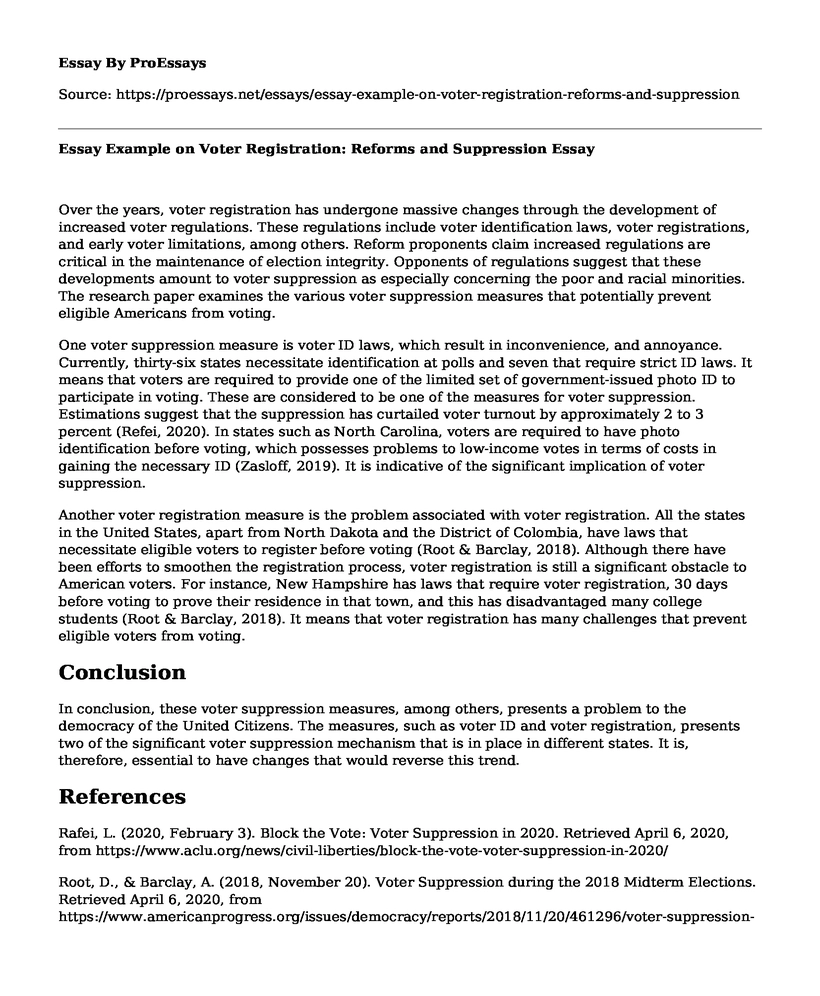Over the years, voter registration has undergone massive changes through the development of increased voter regulations. These regulations include voter identification laws, voter registrations, and early voter limitations, among others. Reform proponents claim increased regulations are critical in the maintenance of election integrity. Opponents of regulations suggest that these developments amount to voter suppression as especially concerning the poor and racial minorities. The research paper examines the various voter suppression measures that potentially prevent eligible Americans from voting.
One voter suppression measure is voter ID laws, which result in inconvenience, and annoyance. Currently, thirty-six states necessitate identification at polls and seven that require strict ID laws. It means that voters are required to provide one of the limited set of government-issued photo ID to participate in voting. These are considered to be one of the measures for voter suppression. Estimations suggest that the suppression has curtailed voter turnout by approximately 2 to 3 percent (Refei, 2020). In states such as North Carolina, voters are required to have photo identification before voting, which possesses problems to low-income votes in terms of costs in gaining the necessary ID (Zasloff, 2019). It is indicative of the significant implication of voter suppression.
Another voter registration measure is the problem associated with voter registration. All the states in the United States, apart from North Dakota and the District of Colombia, have laws that necessitate eligible voters to register before voting (Root & Barclay, 2018). Although there have been efforts to smoothen the registration process, voter registration is still a significant obstacle to American voters. For instance, New Hampshire has laws that require voter registration, 30 days before voting to prove their residence in that town, and this has disadvantaged many college students (Root & Barclay, 2018). It means that voter registration has many challenges that prevent eligible voters from voting.
Conclusion
In conclusion, these voter suppression measures, among others, presents a problem to the democracy of the United Citizens. The measures, such as voter ID and voter registration, presents two of the significant voter suppression mechanism that is in place in different states. It is, therefore, essential to have changes that would reverse this trend.
References
Rafei, L. (2020, February 3). Block the Vote: Voter Suppression in 2020. Retrieved April 6, 2020, from https://www.aclu.org/news/civil-liberties/block-the-vote-voter-suppression-in-2020/
Root, D., & Barclay, A. (2018, November 20). Voter Suppression during the 2018 Midterm Elections. Retrieved April 6, 2020, from https://www.americanprogress.org/issues/democracy/reports/2018/11/20/461296/voter-suppression-2018-midterm-elections/
Zasloff, J. (2019). Jim Crow as Kafka: Voter Suppression on the Ground. SSRN Electronic Journal, 1-26. doi: 10.2139/ssrn.3498498
Cite this page
Essay Example on Voter Registration: Reforms and Suppression. (2023, May 08). Retrieved from https://proessays.net/essays/essay-example-on-voter-registration-reforms-and-suppression
If you are the original author of this essay and no longer wish to have it published on the ProEssays website, please click below to request its removal:
- The News Story About Donald Trump
- Essay Sample on Effective Leadership Practices
- Compare and Contrast Earnest Becker and Erich Fromm and Their Contribution to Karl and Sigmund Freud
- Literary Analysis Essay on After the Arab Spring
- Essay Example on the US: A Superpower Playing a Major Role in Global Politics
- Cultural Policies: Supporting and Protecting Art and Creativity - Essay Sample
- Essay on Modes of Production Determine Social Relations: Marxist Theory of Historical Materialism







